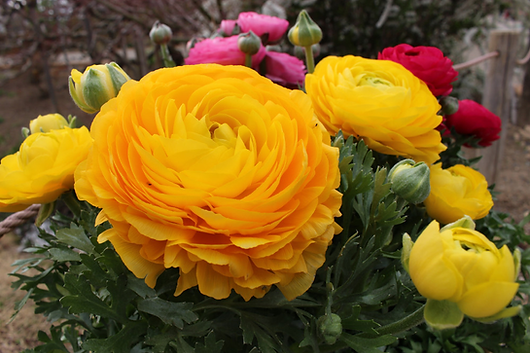Ranunculus flowers are one of the most beautiful flowers around. In my opinion they rival roses, peonies, and tulips. These multi-layered, ruffled flowers are lovely showcased in the spring bordering paths in sunlit gardens. Their striking blossoms also last long as cut flowers in bouquets. Growing ranunculus flowers is easy. Their tubers can be left in the ground if you live in warmer zones resulting in blooms every year. Read on to learn how to grow and care for ranunculus.
What is a Ranunculus?
Ranunculus is a large genus of about 600 species of flowers in the family Ranunculaceae. Other common names are buttercups, including the Persian buttercup, water crowfoots, and spearworts. They come in vibrant colors including red, gold, burgandy and orange, and in more subtle colors such as white, cream, pink and pale yellow. Its botanical name is Ranunculus asiaticus.
Their flowers range in diameter from 2 to 5 inches. The plant will grow from 8 to 18 inches tall, depending on the variety, and from 6 to 12 inches wide. Their long stems are ideal for cutting and the flowers will last 10 to 12 days in a vase if they were cut as buds. In the garden, Ranunculus bloom from early spring to summer.
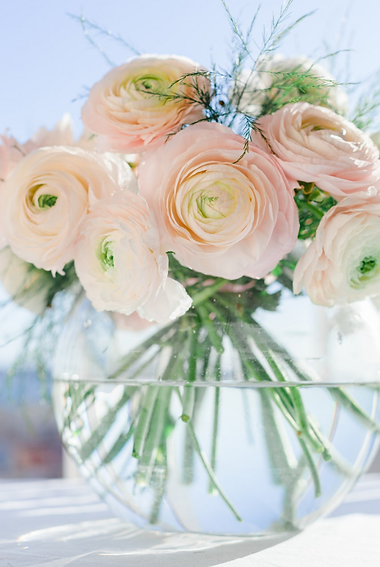
Purchasing Ranunculus – Buying Tips
When researching Ranunculus, they are often referred to as corms, bulbs, and tubers. I will refer to them as tubers in this article.
1. Ranunculus can be grown from seed starting early inside, or from tubers in either the fall or early spring, depending on in which zone you live. They can also be purchased as full blooming plants at nurseries in the spring.
2. Purchase large tubers. Larger tubers produce more blooms. A large tuber can push out 10 to 12 stems with up to 35 large flowers. These large tubers are referred to as “jumbos”. Smaller tubers will produce fewer blossoms.
3. Buy in large quantities. It is cheaper to buy Ranunculus tubers in bulk, perhaps 25 tubers in a package. They can be grown in containers and throughout a sunny garden.
4. Be sure to read the label to see the color your are purchasing. The label will also tell you the height of the stems and the size of the flower.
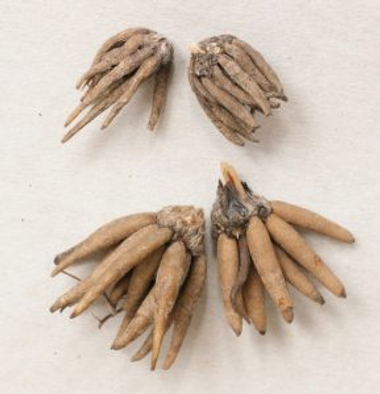
Dried Ranculus tubers and plumped Rananculus tubers
When and Where to Grow Ranunculus
Ranunculus grow from tubers which are specifically formed to house nutrients for the plant. These claw-like tubers grow best in warmer climates where the winters are mild and spring is long and cool. They are winter hardy in zones 8 through 10 where temperatures do not fall below 25 degrees F.
If you live in zones 8 through 10, plant the tubers in the ground in mid fall for spring flowers.
If you live in zones 4 through 7, Ranunculus will not survive the harsh winter. You can either start them from seeds inside (see below) or plant them outside in late winter or early spring once the chance of a hard frost is over. They will bloom from late spring through early summer.
Planting Inside
Another option is to start the plant inside in a container 8 to 12 weeks before your area’s last frost date. Then once the ground has softened, plant it outside.
Ranunculus definitely do not like a warm, soggy environment. Planting them in this type of area will result in rotting tubers.
The map below will help you determine your zone if you live in the United States. If you live outside of the US, google your town and the words “plant hardiness growing zone”.

Growing Ranunculus Plants
Ranunculus thrive in full sunlight but can tolerate a bit of shade.
When planting them in your garden, be sure the soil is rich and well drained. If the area you choose puddles after a rain, to enhance drainage add 2 to 3 inches of compost, peat moss, or other organic soil.
Tip
“Be sure to weed your garden frequently so the Ranunculus does not have to fight for nutrients in the soil.”
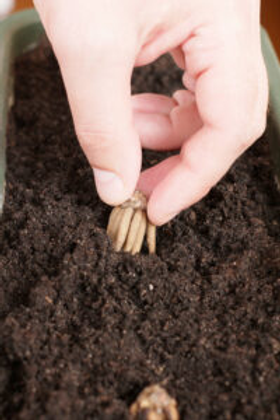
Ranunculus tubers with the claws facing down in the soil.
When you are ready to plant the tubers, soak them in room temperature water for at least 4 hours but no more than 24. You will notice the legs of the tuber, which look like those of a skinny dead spider, start to plump up with moisture. Once plumped, the tuber will resemble a tiny octopus. This gives the plants a head start and will almost guarantee good growth.
Plant the tubers with the claws facing down, 6 to 8 inches apart, then cover them with one inch of soil. Water them well and do not water them again until they begin to sprout.
Cover them with 2 to 3 inches of mulch to retain moisture.
The plants should produce flowers after approximately 90 days.
Planting in Containers
If you choose to plant them in containers, plant 2 jumbo size tubers per each 10 inch diameter pot using the same kind of soil as mentioned above.
Place them in a sunny location outside in early spring. They will survive an occasional freeze.
Cover them with mulch to keep them warm and toasty and retain water.
Once they begin growing, water them to keep them moist but not soggy.
Planting From Seed
Planting Ranunculus from seeds is quite easy. Begin the process in late winter.
Place them in a seed starter container with loose, light weight, peat-based starter mix.
Water them until evenly moist.
Place the seed trays in a cool, dry place, 50 to 60 degrees F, for germination. They can either be placed under a grow light or in an area with indirect light.
Once they begin to sprout, place them in a warmer area with indirect light. Keep them evenly moist until they are planted outside.
Fertilizer
If you are growing Ranunculus as an annual, they will not necessarily need fertilizer. However, to encourage more lush flowers and foliage, fertilize with a liquid fertilizer every 2 weeks once they are growing vigorously.
After the Thrill is Gone
As with any cool weather flower, they will begin to yellow, droop, and wither in the heat of summer.
If you live in a colder environment with harsh winters, you can either dig them out and compost them, or try to retain them during the winter for next year’s blooms. Gently dig the tubers from the ground and cut off the dead foliage. Remove as much soil as possible from between the claws and store them in a cool, dry place for the remainder of the summer, fall and winter.
Begin the process described above again in the spring.
If you live in a warmer environment, cut back the dead foliage and allow them to do their thing for the rest of the year.
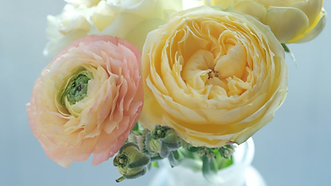
Beautiful Cut Flowers
As I mentioned above, cut Rananculus stems will last up to 12 days in a vase. Wait until the buds are soft and cushy and begin to show faint color before cutting them from the plant.
Cut them first thing in the morning with a sharp pair of scissors, when they are well rested and plump with water.
To inhibit bacteria growth and cloudy water in the vase, add 1/4 teaspoon of bleach to a quart (1 liter) of water. As an alternative, mix 3 drops of bleach with 1 teaspoon of sugar in a quart (1 liter) of water.
Like Ranunculus, tulips can also be placed in a vase and used in bouquets. For more on tulips, read Let’s Talk Tulips.
Growing Ranunculus Flowers is Easy!
After following the instructions above, I’m sure you’ll agree that planting and caring for Ranunculus is rather easy. There is nothing more beautiful than a vase full of colorful Ranunculus to brighten your day and raise your spirits.
I hope you were inspired enough by this article to grow them in your garden. They will be a welcome reminder that summer is just around the corner!
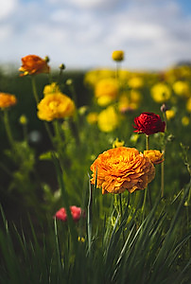
Please leave a comment below and share with family and friends!
Happy Gardening!
Nina
bestgardeningforbeginners@gmail.com

